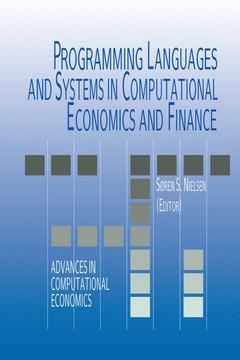Description
Programming Languages and Systems in Computational Economics and Finance, Softcover reprint of the original 1st ed. 2002
Advances in Computational Economics Series, Vol. 18
Coordinator: Nielsen Soren Bo
Language: English
Subjects for Programming Languages and Systems in Computational...:
Programming Languages and Systems in Computational Economics and Finance
Publication date: 10-2012
460 p. · 16x24 cm · Paperback
Publication date: 10-2012
460 p. · 16x24 cm · Paperback
Programming languages and systems in computational economics and finance
Publication date: 08-2002
460 p. · 15.5x23.5 cm · Paperback
Publication date: 08-2002
460 p. · 15.5x23.5 cm · Paperback
Description
/li>Contents
/li>
The developments within the computationally and numerically oriented ar eas of Operations Research, Finance, Statistics and Economics have been sig nificant over the past few decades. Each area has been developing its own computer systems and languages that suit its needs, but there is relatively little cross-fertilization among them yet. This volume contains a collection of papers that each highlights a particular system, language, model or paradigm from one of the computational disciplines, aimed at researchers and practitioners from the other fields. The 15 papers cover a number of relevant topics: Models and Modelling in Operations Research and Economics, novel High-level and Object-Oriented approaches to programming, through advanced uses of Maple and MATLAB, and applications and solution of Differential Equations in Finance. It is hoped that the material in this volume will whet the reader's appetite for discovering and exploring new approaches to old problems, and in the longer run facilitate cross-fertilization among the fields. We would like to thank the contributing authors, the reviewers, the publisher, and last, but not least, Jesper Saxtorph, Anders Nielsen, and Thomas Stidsen for invaluable technical assistance.
Preface. Contributing Authors. Part I: Models and Modelling. 1. Coin-or: An Open-Source Library for Optimization; M.J. Saltzman. 2. Macroeconomics: What can we learn from the Dynamical Systems Literature? P. Gomis-Porqueras, À. Haro. 3. The rapid implementation of asset/liability models for risk management; J.L. Kruiser. 4. Human and Organization Challenges to the Use of Optimization; D.E. Shobrys. Part II: High-level and Object Oriented Approaches. 5. Object-oriented Programming using Ox; J.A. Doornik. 6. Design Patterns in Hierarchical Models; C.R. Birchenhall. 7. Facilitating applied economic research with Stata; C.F. Baum. 8. Formulation of Linear Optimization Problems in C++; T.H. Hultberg. Part III: Maple and MATLAB. 9. MAPLE and MATLAB for Stochastic Differential Equations in Finance; D.J. Higham, P.E. Kloeden. 10. Computational Programming Environments; R.D. Herbert. 11. Statistics and simulations with Maple; J. Ombach, J. Jarnicka. 12. MATLAB as a Flexible Tool for Data Analysis and Optimisation; G.R. Lindfield, J.E.T. Penny. Part IV: Options and Differential Equations. 13. Option pricing with Excel; P. Honoré, R. Poulsen. 14. Numerical solution of boundary value problems in computational finance; J. Hugger. 15. MAPLE for Jump-Diffusion Stochastic Differential Equations in Finance; S. Cyganowski, et al.
© 2024 LAVOISIER S.A.S.




